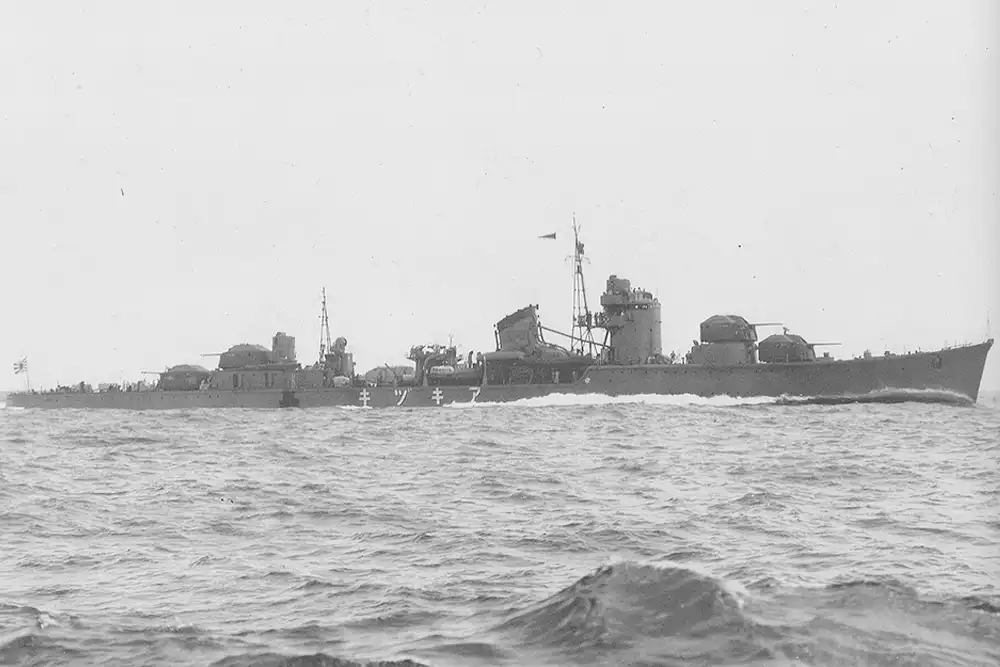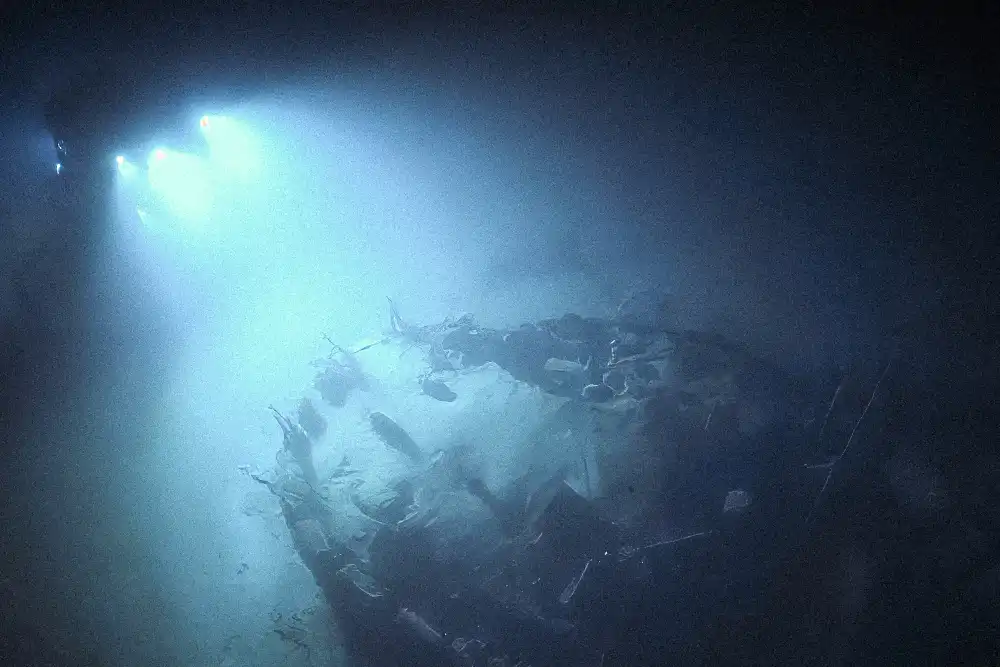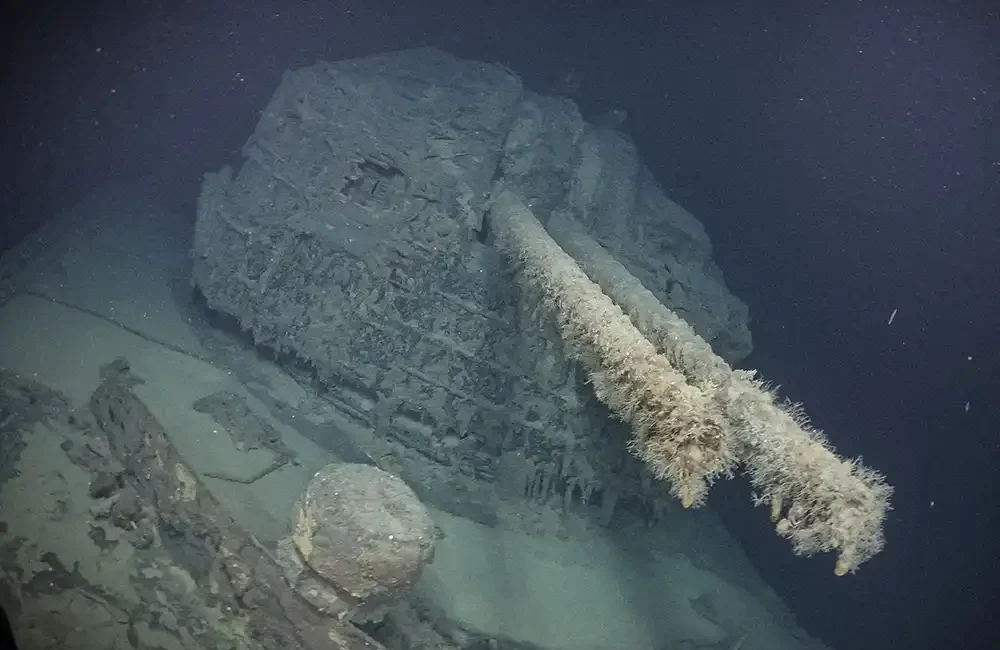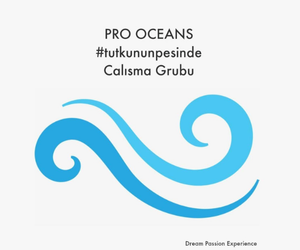By Mark ‘Crowley’ Russell
The wreckage of the Second World War Imperial Japanese Navy destroyer Teruzuki has been discovered in the Solomon Islands, 83 years after she was sunk by American torpedo patrol boats.
The ship was located by a team of scientists on board the Ocean Exploration Trust (OET)’s Exploration Vessel Nautilus at a depth of 800 meters in Iron Bottom Sound – the name bestowed on a stretch of water in the Solomon Islands for the sheer amount of ships and aircraft sunk there during the Pacific naval battles.
The team used remotely operated vehicles (ROVs) Hercules and Atalanta to investigate a target previously found during seafloor mapping operations by the University of New Hampshire’s uncrewed surface vessel (USV) DriX.
Details from the survey have rewritten the generally accepted story of Teruzuki’s fate, as the reported manner of her sinking due to an explosion in her depth charge magazine appears to have been disproved by footage of the stern section recorded by the ROVs.

Teruzuki – 照月 in Japanese Kanji, which translates as ‘shining moon’ – was a 134 metre-long Akizuki-class destroyer, one of 13 built for the Imperial Japanese Navy (IJN) between 1940-1945.
Akizuki (秋月, meaning ‘Autumn’) were designed primarily as anti-aircraft escorts for aircraft carriers but also carried torpedoes and depth charges together with their batteries of dual-purpose guns, making them effective multi-purpose vessels.
Laid down at the Mitsubishi shipyard in Nagasaki in November 1940 and completed in August 1942, Teruzuki would serve less than four months before being sunk in December 1942 during the Battle of Guadalcanal.
Guadalcanal – the largest of the Solomon Islands – was the scene of some of the most devastating Naval conflict of the Second World War, as Japanese and American forces fought for control of the strategically important island between August 1942 and February 1943.


Teruzuki had been undergoing repairs at the Imperial Navy’s base in Chuuk Lagoon when she was ordered to join the Japanese ‘Vanguard Force’ in November 1942.
During the Naval Battle of Guadalcanal between 12 to 15 November, Teruzuki was instrumental in the sinking of two US destroyers, Laffey and Monssen, and disabling at least two others,
Cushing and Sterett, before the Japanese ships were forced to withdraw.
Teruzuki returned to Chuuk and was appointed as the flagship of Rear Admiral Raizou Tanaka, a highly respected sailor nicknamed ‘Tenacious Tanaka’ by US forces for his nighttime attacks and torpedo expertise.
Four months into the Guadalcanal campaign, the Japanese troops stationed on the island were in desperate need of supplies, but US forces were successful in preventing the IJN’s ships from landing.

Nicknamed the ‘Tokyo Express’, Tanaka’s ships delivered supplies at high speed during the night, dropping sealed steel containers into the water in the hope they would drift towards shore with the current.
On 11 December, Teruzuki was tasked with escorting a convoy sent to resupply Japanese troops on Guadalcanal’s northern coast.
The convoy survived an attack by US bombers, but shortly after dropping their supplies, they were intercepted by American PT boats – fast patrol torpedo attack boats – and Teruzuki was struck twice in her stern at around 1.20 in the morning.
The explosion smashed Teruzuki’s rudder and damaged one of her prop shafts, leaving her disabled as fire broke out in a ruptured oil tank. Most of the crew were either rescued or were able to swim to shore, however, nine men of her 353-man crew were killed during the attack.

It has been previously accepted that Teruzuki sank when fire spread to her depth charge magazine, triggering an explosion which severed the hull.
During the OET surveys, however, the exploration team found a 19-meter-long severed segment of Teruzuki’s stern approximately 200 metres from the rest of the ship, still littered with intact depth charges.
The team says the finding disproves the long-held theory that it was depth charge explosions that caused the ship to sink, indicating that it was the American torpedoes which sealed Teruzuki’s fate.
‘I feel so lucky to see this ship. The fact that we have not seen Teruzuki in over 80 years underscores the importance of recording maritime heritage now,’ said Hiroshi Ishii, Nautilus science team member and Researcher at the Centre for Southeast Asian Studies at Kyoto University.
‘As a Japanese person, I appreciate the opportunity to witness part of our history and to be part of an international team shedding light on this campaign, which is important to all of our nations’ history.’

‘The discovery of Rear Admiral Tanaka’s flagship Teruzuki was made by a multidisciplinary, international team who together documented its remains, uncovering Teruzuki’s significance to former combatant, and now allied, nations,’ said Phil Hartmeyer, marine archaeologist from NOAA Ocean Exploration.
‘Only by exploring our planet’s unknown waters can these significant stories of sacrifice and human connection to our ocean be brought to light.’
Teruzuki’s discovery is from an ongoing expedition to explore Iron Bottom Sound led by OET and supported by NOAA Ocean Exploration via the Ocean Exploration Cooperative Institute. The surveys are streamed live on NautilusLive.org, and oyou can follow the team on Instagram @nautiluslive and Facebook @nautiluslive.
The post Lost WWII Japanese warship Teruzuki discovered in Solomon Islands appeared first on DIVE Magazine.




